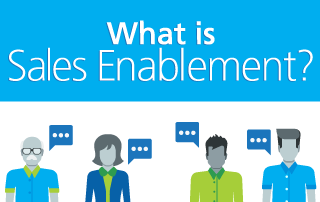sales-enablement
9 Reasons Why Companies Start Sales Enablement
One thing we hear time and time again from our clients is that they can’t imagine working without their sales enablement platform. It has transformed the way they approach the sales process so much that it is simply unthinkable to go back to the manual, disorganized way they used to sell. But one area that is often very different from business to business is the reason why they decided to take the plunge toward enabling sales. Read over the following reasons our clients have started sales enablement and see if any of them sound like the current state of your company.
1. Revenue Goals Were Growing, But Revenue Wasn’t
According to the CSO Insights Sales Enablement Optimization Study, increasing revenue was the number one goal for business leaders in 2016. There is constant pressure from shareholders or board members to raise sales numbers. While that can be a powerful motivator, there’s only so much you can do to encourage your sales reps to meet revenue goals. These clients needed an extra boost in sales performance to meet those goals.
2. Another Department Was Complaining about Sales Requests
When you look at the departments that most often intersect with sales, such as marketing or customer retention, how smooth is the communication and collaboration? For many businesses, “not smooth at all” is the response.
Often, the marketing team is the one to spur on an enablement initiative simply so that sales reps can take care of creating presentations or sales kits by themselves. The marketing team gets more time to focus on their lead generation efforts, and the sales reps don’t have to wait in a marketing content queue for two days while a buyer is waiting for information.
3. Marketing Was Bringing in Leads, but Sales Couldn’t Close Them
A bottlenecked sales funnel is a big problem. The kneejerk reaction might be to blame the sales team for their inability to close deals, but quite often, the problem is more big picture. If marketing isn’t bringing in the right type of leads, the buyers will quickly realize that the solution is not a good fit and opt out of the sales process. That’s just one of many possible scenarios, but fortunately, sales enablement initiatives are tailored to resolve the specific issues within your business.
4. The Company Had No Idea What Was Working/Broken
Visibility is key to business success. If you can’t clearly see how your sales team is performing, make accurate forecasts about projected revenue, or identify areas for improvement, your entire business strategy could fall apart. Companies usually have tons of sales data at their disposal, but that data is stored in a CRM in a way that is difficult to access of interpret. For these companies, the sales enablement initiative was a way to clear the air and see exactly what was going on in order to make strategic decisions moving forward.
5. Sales Rep Ramp Up Time Was Horrendous
According to the Training Industry, it takes an average of 6 months to fully ramp up a sales rep. Here’s an even more sobering statistic: average sales rep tenure at a company is only 2 years. So during 1/4th of the time you have with a sales rep, that rep isn’t fully contributing to company goals. Sales enablement initiatives have been proven to shorten the ramp up/training time for sales reps and increase rep tenure. Those reps start contributing faster and they continue contributing for a longer period, and the resulting revenue numbers are quite positive.
6. The Sales Process Didn’t Match the Sales Actions
It’s common for companies to have a documented sales process or methodology, and it’s also likely that the methodology is the basis for onramping new sales team members. But what is unfortunately also very common is for reps to get through the formal training and then get a second, informal training of “how things really work.” While the documented sales process might say to take one approach, different members of the sales team might veer off in completely different directions depending on what’s easiest or sensible to them.
It’s chaos, and there’s no way to systematically make adjustments when there’s no clear process to follow. In this instance, a sales enablement initiative serves to adjust things from both sides: fixing the process where it’s complicated or unnecessary and fixing where reps aren’t following the process when they should be.
7. Sales Reps Were Only Spending a Fraction of Time Actually Selling
A lot of processes can cut into selling time. An Accenture study found that meetings take up 17.3% of sales rep time each week. Training, travel, research, and even searching for that perfect sales presentation template all eat away at that time allocated to prospect engagement. Once a company comes to the realization that the reps they hired to sell are spending very little time actually selling, the need for a sales enablement solution becomes very clear.
SEE ALSO: Why you need to increase sales rep selling time (and how to do it)
8. The CRM Was Out of Date, Inaccurate, and Difficult to Use
Ah, Salesforce, the software that every sales rep has a love-hate relationship with. Yes, it’s necessary to have some kind of repository for prospect data, but why on earth is everyone using such a clunky, unintuitive software? Well, the answer is that not everyone is. In fact, the vast majority of CRM data is out of date, inaccurate, or missing entirely.
A 2015 study by Capterra found that businesses spent an average of $150 a month for each CRM user, and it wouldn’t surprise us if that number were much higher as of 2017. That’s a lot of cash for a program that doesn’t offer much value in return. That’s where sales enablement software comes in. It takes the good from CRM and leaves the disorganized, complicated mess behind.
9. A Competitor Was Doing It (and It Showed)
Have you ever been in a situation where a certain competitor seemed be snatching up every deal you were going for? If one of your competitors has invested in sales enablement, the last thing you want to do is let them keep that head start for long. The enablement initiative will help your competitor’s sales team operate more efficiently and effectively. When faced with that prospect, sales enablement moves from a “nice to have” to a “absolutely must have.”











